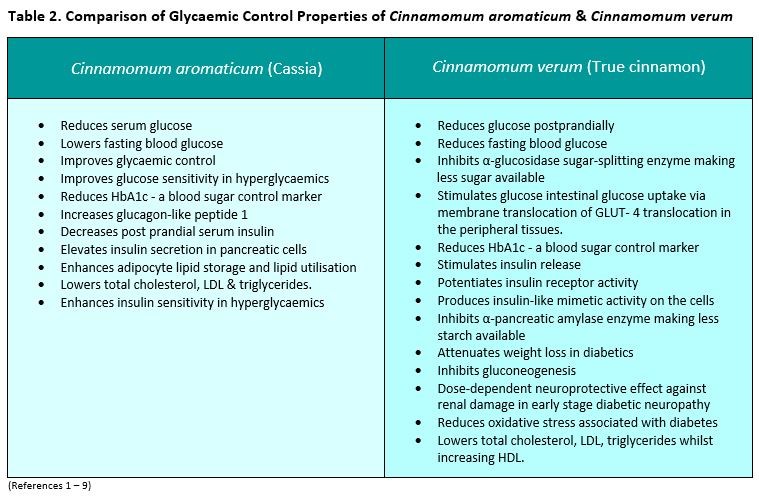This research provides an excellent example how different types of a herb have different actions on the body. When you purchase cinnamon over-the-counter or on-line, you have no guarantee that you are actually receiving the species that will be beneficial for your health. True Medicine only stocks products that have proven efficacy, are quality controlled to ensure correct species of herbs used and contain high-grade ingredients. Here’s the low-down on Cinnamon and its anti-diabetic properties:
Cinnamon has a long history of domestic and medicinal use going back several hundred years. It is has been used in Ayurvedic and Traditional Chinese medicine since ancient times and has recently received researchers attention due to its extensive range of medicinal properties such as anti-diabetic, antimicrobial, antiviral, antioxidant, gastro-protective and cholesterol lowering properties. (1) Of the approximately 250 species in the genera, the bark of at least four are used domestically. However, only two of these species are widely available commercially in Australia. These are: Cinnamomum zeylanicum (also called C. verum or true cinnamon), from Sri Lanka and Cinnamomun aromaticum (commonly known as Cassia) from China, Vietnam, India and Indonesia. In this article we take a look at the difference between these two species, exploring and comparing their physical and anti-diabetic properties. (1)
Modes of Action
Current research demonstrates that cinnamon appears to exert its blood sugar regulating effects through a number of mechanisms. Firstly, the beneficial effects of cinnamon on blood sugar control may be due to its polyphenol content. Polyphenols and active compounds such as cinnamtannin B1, catechin, epicatechin and procyanidin B2 have been shown to lower insulin postprandially. The mechanism operates via cinnamon polyphenols activating insulin receptors by increasing tyrosine phosphorylation activity and thereby inactivating the insulin receptor. (2,3)
Cinnamon can also alter gene expression to produce blood sugar lowering and insulin-mimicking properties by decreasing the gene expression of two important regulators of hepatic gluconeogenesis: phosphoenolpyruvate carboxykinase and glucose-6-phosphatase. Other research shows that cinnamon polyphenols exert a pancreatic β-cell protective effect which is another important mechanism by which cinnamon exerts its anti-diabetic effect. (2, 4)
Cinnamon also promotes peripheral glucose uptake by stimulating glucose transporter 4 (GLUT-4) receptor synthesis and translocation, effectively modulating hepatic glucose metabolism through changes in Pyruvate kinase (PK). Lastly, cinnamon inhibits sugar and starch uptake from the intestines through Pyruvate Carboxikinase (PEPCK), altering the expression of PPAR (γ) and inhibiting the activity of intestinal glucosidase and pancreatic amylase. (4)
Safety of Commercial Cinnamon Species
The chemical composition of True cinnamon and Cassia are quite different with regard to their coumarin content. Whilst Cassia contains between 700 – 12,230 mg/kg, True cinnamon levels were below the detectable limits. This raises significant concerns about the potential toxicity of Cassia, due to the high levels of coumarin, a noted hepatotoxin. On the other hand, not only is true cinnamon non-toxic, it has also shown hepatoprotective effects in preclinical trials, where it reduced elevated liver enzymes in mice who were exposed to carbon tetrachloride for 28 days and it simultaneously increased their levels of the potent endogenous antioxidants superoxide dismutase and catalase.(5,6)
Comparing Their Anti-diabetic Properties
There is a modest, yet growing body of research examining the anti-diabetic properties of Cinnamon species, Cinnamomum verum and Cinnamomum aromaticum have demonstrated a multiplicity of modest but consistent anti-diabetic effects in vitro and in vivo, with larger human trials in progress. See Table 1. below for a comparison of the glycaemic control properties of true cinnamon and cassia species. It highlights the diverse ways that cinnamon exerts its anti-diabetic effects. (4)

The long history of domestic and traditional medicinal use of true cinnamon (C. verum) bark and it’s reported low toxicity compared to Cassia (Cinnamomum aromaticum) bark suggest it is may be the safer choice when employed as part of a blood sugar control protocol and can also be considered for ameliorating the effects of some metabolic syndrome symptoms due to its insulin mimicking, cholesterol and lipid lowering effects. Additionally, it may prove useful in helping mitigating the damaging effects of long term hyperglycaemia due to the neuroprotective properties it exhibits in early stage diabetic neuropathy. (1)
Article Courtesy of InterClinical Laboratories.
References:
1. Bandara T, Uluwaduge I, Jansz ER. Bioactivity of cinnamon with special emphasis on diabetes mellitus: a review. International Journal of Food Sciences and Nutrition. 2012;63(3):380-6.
2. Cheng DM, Kuhn P, Poulev A, Rojo LE, Lila MA, Raskin I. In vivo and in vitro antidiabetic effects of aqueous cinnamon extract and cinnamon polyphenol-enhanced food matrix. Food chemistry. 2012 Dec 15;135(4):2994-3002.
3. Khangholi S, Majid FA, Berwary NJ, Ahmad F, Aziz RB. The mechanisms of inhibition of advanced glycation end products formation through polyphenols in hyperglycemic condition. Planta medica. 2016 Jan;82(01/02):32-45.
4. Sun P, Wang T, Chen L, Yu BW, Jia Q, Chen KX, Fan HM, Li YM, Wang HY. Trimer procyanidin oligomers contribute to the protective effects of cinnamon extracts on pancreatic β-cells in vitro. Acta Pharmacologica Sinica.;37(8):1083.
5. Medagama AB. The glycaemic outcomes of Cinnamon, a review of the experimental evidence and clinical trials. Nutrition journal. 2015 Dec;14(1):108.
6. Ranasinghe, P., and P. Galappaththy. “Health benefits of Ceylon cinnamon (Cinnamomum zeylanicum): a summary of the current evidence.” Ceylon Medical Journal 2016; 61(1)
7. Kwak JS, Kwon O. Effect of cassia cinnamon intake on improvement of the glycemic response: An updated meta-analysis: Focus on preparation of dehydrated powder and water extract. Journal of Nutrition and Health. 2017;50(5):437-46.
8. Lee S, Siaw J, Kang H. Stimulatory Effects of Cinnamon Extract (Cinnamomum cassia) during the initiation stage of 3T3-L1 adipocyte differentiation. Foods. 2016;5(4):83.
9. Anderson RA, Zhan Z, Luo R, Guo X, Guo Q, Zhou J, Kong J, Davis PA, Stoecker BJ. Cinnamon extract lowers glucose, insulin and cholesterol in people with elevated serum glucose. Journal of traditional and complementary medicine. 2016;6(4):332-6.

